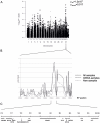Identification of a novel idiopathic epilepsy locus in Belgian Shepherd dogs
- PMID: 22457775
- PMCID: PMC3311644
- DOI: 10.1371/journal.pone.0033549
Identification of a novel idiopathic epilepsy locus in Belgian Shepherd dogs
Abstract
Epilepsy is the most common neurological disorder in dogs, with an incidence ranging from 0.5% to up to 20% in particular breeds. Canine epilepsy can be etiologically defined as idiopathic or symptomatic. Epileptic seizures may be classified as focal with or without secondary generalization, or as primary generalized. Nine genes have been identified for symptomatic (storage diseases) and one for idiopathic epilepsy in different breeds. However, the genetic background of common canine epilepsies remains unknown. We have studied the clinical and genetic background of epilepsy in Belgian Shepherds. We collected 159 cases and 148 controls and confirmed the presence of epilepsy through epilepsy questionnaires and clinical examinations. The MRI was normal while interictal EEG revealed abnormalities and variable foci in the clinically examined affected dogs. A genome-wide association study using Affymetrix 50K SNP arrays in 40 cases and 44 controls mapped the epilepsy locus on CFA37, which was replicated in an independent cohort (81 cases and 88 controls; combined p = 9.70×10⁻¹⁰, OR = 3.3). Fine mapping study defined a ∼1 Mb region including 12 genes of which none are known epilepsy genes or encode ion channels. Exonic sequencing was performed for two candidate genes, KLF7 and ADAM23. No variation was found in KLF7 but a highly-associated non-synonymous variant, G1203A (R387H) was present in the ADAM23 gene (p = 3.7×10⁻⁸, OR = 3.9 for homozygosity). Homozygosity for a two-SNP haplotype within the ADAM23 gene conferred the highest risk for epilepsy (p = 6.28×10⁻¹¹, OR = 7.4). ADAM23 interacts with known epilepsy proteins LGI1 and LGI2. However, our data suggests that the ADAM23 variant is a polymorphism and we have initiated a targeted re-sequencing study across the locus to identify the causative mutation. It would establish the affected breed as a novel therapeutic model, help to develop a DNA test for breeding purposes and introduce a novel candidate gene for human idiopathic epilepsies.
Conflict of interest statement
Figures


References
-
- Engel J., Jr Intractable epilepsy: Definition and neurobiology. Epilepsia. 2001;42(Suppl 6):3. - PubMed
-
- Berendt M, Gredal H, Alving J. Characteristics and phenomenology of epileptic partial seizures in dogs: Similarities with human seizure semiology. Epilepsy Res. 2004;61(1–3):167–173. 10.1016/j.eplepsyres.2004.07.009. - PubMed
-
- Berendt M, Gredal H, Ersboll AK, Alving J. Premature death, risk factors, and life patterns in dogs with epilepsy. J Vet Intern Med. 2007;21(4):754–759. - PubMed
Publication types
MeSH terms
LinkOut - more resources
Full Text Sources
Medical
Miscellaneous

